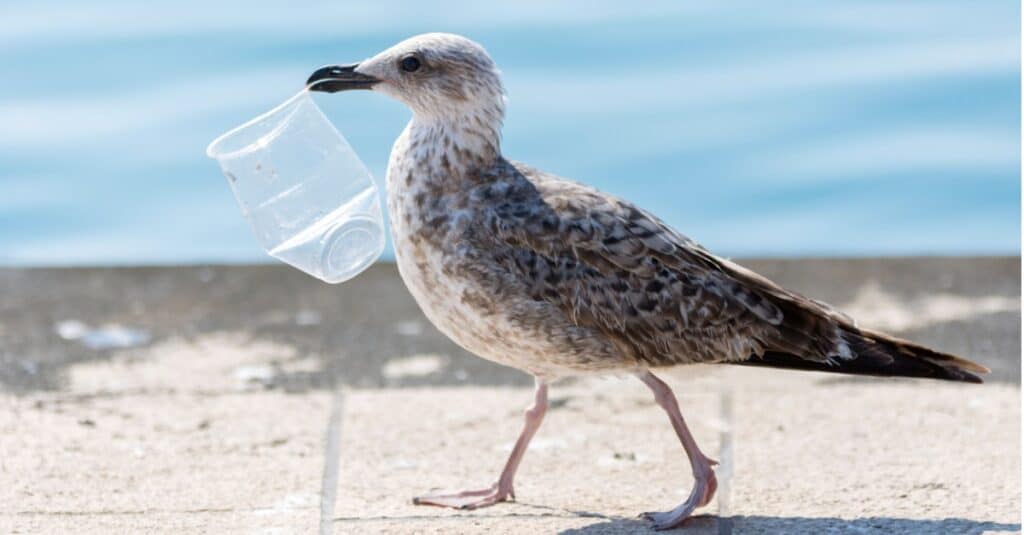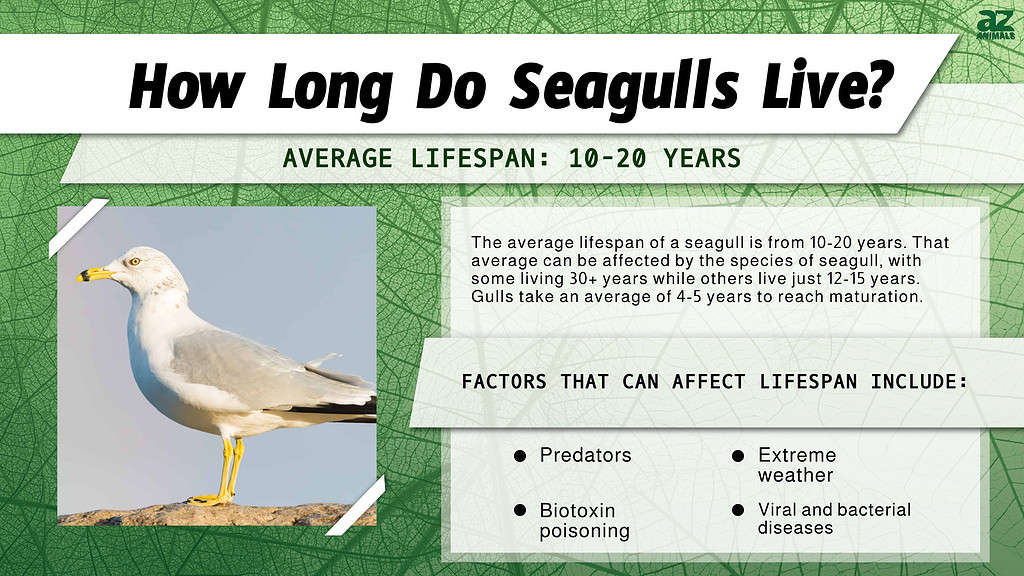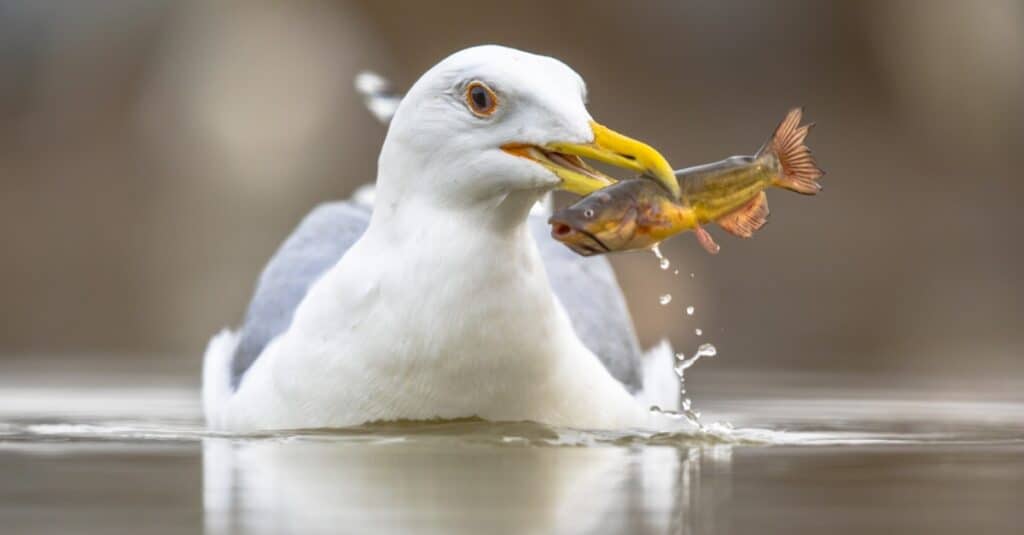Anytime you’re near the ocean or the coast, it’s almost assured you’ll encounter a seagull. But how much do you really know about this clever foraging bird? Surprisingly, you may not know a whole lot! After all, the term “seagull” has been used to describe almost all gray and white rowdy birds located near the sea. However, there are around 28 distinct seagull subspecies found across the world.
While the birds’ loud squawks and fluttering may appear to be disordered to us, they are really part of a complicated communication system meant to ensure order among the birds. Together, let’s learn what makes these birds so special and unique from other bird species. We’ll uncover just how long seagulls live as well as what impacts their lifespan out in the wild.
Quick Crash Course on Seagulls

Seagulls have been observed using targeted tactics in order to steal food from other wildlife and even people.
©iStock.com/Robert Pleško
Seagulls can be found all across the world, including the Antarctic continent’s borders and the high Arctic. They are mostly found around the shore, although they may also be found near sources of freshwater. Their extremely adaptive nature and intellect are what sets them apart from so many other birds.
Evolutionary biologists who have examined these birds’ behavior agree that they are highly adaptive. They are opportunistic foragers who will even steal food from humans – anyone who has had a beach picnic can confirm this! Another fun fact that separates them from many other birds is that they can drink saltwater. This is thanks to the presence of a unique pair of glands directly above their eyes. These glands aid in the removal of excess salt from the body via holes in the bill.
Seagulls, like humans, are also a monogamous species. They will search for a partner and remain with them until one of them dies, creating a lifelong relationship with their chosen partner. They will help their mates raise babies, make nests, and obtain food.
Now that we have a better understanding of what makes seagulls so special, let’s explore just how long seagulls live!
How Long Do Seagulls Live?

On average, the lifespan of a seagull in the wild is between 10 to 20 years. Nevertheless, the type of seagull can make a significant difference to these figures. Herring gulls, for example, can live for up to 30 years or more, with a maximum age of 49 years recorded for the herring gull. Ring-billed gulls typically live for 12 to 15 years.
According to reports, a bird that was present when the Berlin Wall collapsed may be the world’s oldest currently living seagull after reaching the fantastic age of 32. It is considered to be the world’s oldest living black-headed gull, having lived three times as long as other gulls.
There is also Norway’s oldest seagull, Emma, who has set a new national record after reaching 33 years of age.
The Average Seagull Life Cycle

In the wild, seagulls live for about 10 to 20 years.
©iStock.com/Evgenyi_Eg
Seagulls have a similar life cycle to many other bird species. They go through the typical life cycle stages which include: egg, chick, juvenile, and adult.
Egg
Seagull eggs are typically laid around the beginning of May. Seagull eggs are generally dark tan to brown or dark olive in color, with dark splotches and scribble patterns that help them camouflage and blend in with their surroundings to avoid predation. The eggs are incubated by both sexes, with one parent incubating for one to four hours during the day and the other parent incubating all night.
Gull Chicks
Baby seagulls are called gull chicks. The chicks are covered in down as soon as they hatch. Both parents feed the chicks once they hatch. Young chicks are watched over by their parents for about a week, and at least one parent often stays with them, until they fledge, to protect them. Chicks usually start flying in late July or early August.
Juvenile
Instead of being pristine white with grey wings, first-year juvenile seagulls have blotchy grey, black, and white feathers on their wings, brown specks on cream along their neck and head, and a black beak. It takes seagulls three to four years to reach maturity.
Adulthood
At the age of four, they reach full adulthood and are able to reproduce. The biggest gulls, such as the Herring and Black-backed gulls, can take up to five years to mature. They mature much later than many other birds because of how much longer their lifespan is.
What Affects The Lifespan of Seagulls?

Harsh weather is a factor that affects seagulls’ lifespan.
©iStock.com/CreativeNature_nl
The lifespan of a seagull is influenced by a variety of factors, including food supply, predator protection, and harsh weather. If juvenile gulls survive the challenges of their first year in the wild, their odds of survival rise dramatically and continue to grow with each passing year.
Many seagulls are also victims of other creatures in the wild.
Some of the biggest predators to seagulls include:
Outside of predation, in the United States, biotoxin poisoning is the main cause of death for many seagulls and seabirds in general, killing tens of thousands each year. Diseases, both viral and bacterial, are the second most common cause of death, accounting for 20% of bird mortality between 1971 and 2005. The most common diseases among sick birds included avian cholera, paramyxovirus, West Nile virus, and salmonellosis. It was less likely for seagulls and other species of seabirds to die from extreme weather, heavy metals, pesticides, or accidents involving powerlines.
The photo featured at the top of this post is © iStock.com/CreativeNature_nl
Thank you for reading! Have some feedback for us? Contact the AZ Animals editorial team.






